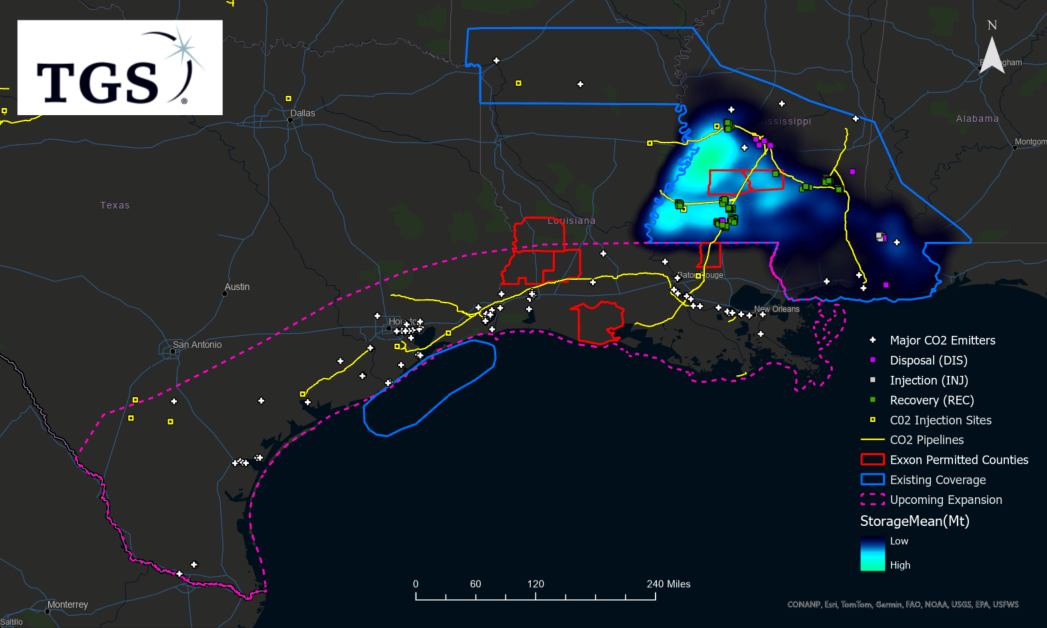Assessing storage capacity and suitability with TGS subsurface data and interpretations.
In a landmark transaction valued at $4.9 billion, ExxonMobil Corporation has successfully acquired Denbury Inc. This strategic move cements ExxonMobil as a key player in Carbon Capture, Utilization, and Storage (CCUS), amplifying its commitment to environmental stewardship. A significant outcome of this deal is the establishment of ExxonMobil as the proprietor of the largest operated CO2 pipeline network in the United States, coupled with access to over 15 onshore CO2 storage sites, as denoted in Figure 1. This arsenal of assets will be instrumental in ExxonMobil's ambitious goal of achieving net-zero greenhouse gas emissions for its operated assets by 2050. The acquisition includes significant operational areas in the Gulf Coast and Rocky Mountain regions. As these assets are developed and optimized, they have the potential to significantly reduce CO2 emissions, with an estimated reduction of over 100 million metric tons annually. TGS subsurface data and interpretive products validate storage capacity and suitability and provide formation specific insight such as for the Lower Wilcox.

Figure 1. TGS interpretation from the Lower Wilcox geologic formation covering AR-MS-AL, ExxonMobil’s CO2 sites, pipeline infrastructure (in yellow), and ExxonMobil’s existing projects and Class VI permits (outlined in red).
ExxonMobil has been given exclusive rights to operate and develop a CO2 sequestration site in Mississippi's Simpson and Copiah Counties, covering approximately 16,000 acres of subsurface pore space. This site, strategically located adjacent to ExxonMobil’s NEJD Pipeline, is poised to play a pivotal role in permanently sequestering industrial CO2 in underground geological formations . With an estimated capacity of 275 million metric tons, the site exhibits favorable characteristics for Carbon Capture and Storage (CCS), as corroborated by TGS Carbon AXIOM's data. According to interpretations, the Lower Wilcox geologic formation in the area (Figure 1) has an average net thickness of 515 feet, 22% effective porosity, and 0.85 md of permeability. This geologic formation is one of many in the area that could be targeted by ExxonMobil.
Notably, this strategic move aligns seamlessly with the prevailing regulatory landscape in the US, particularly the new primacy law governing CO2 projects, ensuring compliance with federal environmental regulations and standards. Louisiana's recent attainment of primacy over carbon sequestration injection wells stands as a crucial development, significantly streamlining approval processes for CCS projects in the state. As of January 2024, Louisiana has taken charge of 56 Class VI permit applications, a key regulatory requirement for the injection of CO2 into deep underground formations for long-term storage. ExxonMobil's commitment to environmental sustainability is further evident in its exploration of CCS with existing Class VI projects and permits in Louisiana, as shown in Figure 1. The St. Helena Parish project has geological characteristics akin to the Mississippi site within the Lower Wilcox unit, along with other geological formations . According to TGS interpretations, this project site has the capacity to store up to 6.47 million metric tons of CO2 permanently within the Lower Wilcox Formation . TGS’ upcoming expansion along the Gulf Coast will help to further analyze ExxonMobil’s pending projects and Class VI permits.
In conclusion, ExxonMobil's strategic acquisition of Denbury marks a transformative chapter in the realm of CO2 capture, storage, and sequestration. The company's comprehensive approach, encompassing strategic locations, advanced infrastructure, and compliance with evolving regulatory frameworks positions it as a trailblazer in the pursuit of a sustainable, low-carbon future.
For more information on TGS Well Data Products, carbon storage assessment, and to schedule a demo, contact us at WDPSales@tgs.com.


